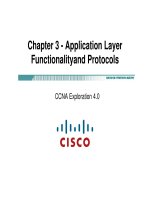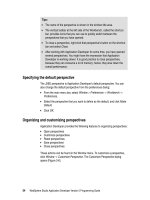9. Application Layer
Bạn đang xem bản rút gọn của tài liệu. Xem và tải ngay bản đầy đủ của tài liệu tại đây (1000.7 KB, 44 trang )
Chapter 9:
Application Layer
Network Basics
Presentation_ID
© 2008 Cisco Systems, Inc. All rights reserved.
Cisco Confidential
1
Chapter 9 Objectives
Explain how the functions of the application layer, session layer, and presentation layer work together to provide network services to end
user applications.
Describe how common application layer protocols interact with end user applications.
Describe, at a high level, common application layer protocols that provide Internet services to end-users, including WWW services and email.
Describe application layer protocols that provide IP addressing services, including DNS and DHCP.
Describe the features and operation of well-known application layer protocols that allow for file sharing services, including: FTP, File Sharing
Services, SMB protocol.
Explain how data is moved across the network, from opening an application to receiving data.
Presentation_ID
© 2008 Cisco Systems, Inc. All rights reserved.
Cisco Confidential
2
Chapter 9
9.1 Application Layer Protocols
9.2 Well-Known Application Layer Protocols and Service
9.3 The Message Heard Around the World
9.4 Summary
Presentation_ID
© 2008 Cisco Systems, Inc. All rights reserved.
Cisco Confidential
3
9.1 Application Layer Protocols
The Application Layer provides the interface to the network.
Presentation_ID
© 2008 Cisco Systems, Inc. All rights reserved.
Cisco Confidential
4
Application, Session and Presentation
OSI and TCP/IP Models Revisited
The key parallels are in the transport and network layer
Presentation_ID
© 2008 Cisco Systems, Inc. All rights reserved.
.
Cisco Confidential
5
Application Session and Presentation
Application Layer
Presentation_ID
© 2008 Cisco Systems, Inc. All rights reserved.
Cisco Confidential
6
Application, Session and Presentation
Presentation and Session Layers
Presentation layer has three primary functions:
•
•
•
Coding and conversion of application layer data
Compression of the data
Encryption of the data for transmission and the decryption of data upon receipt by the
destination
Session Layer
•
•
Functions create and maintain dialogs between source and destination applications
Handles the exchange of information to initiate dialogs, keep them active, and to
restart sessions
Presentation_ID
© 2008 Cisco Systems, Inc. All rights reserved.
Cisco Confidential
7
Application, Session and Presentation
Presentation and Session Layers
Presentation_ID
© 2008 Cisco Systems, Inc. All rights reserved.
Cisco Confidential
8
Application, Session and Presentation
TCP/IP Application Layer Protocols
Domain Name Service Protocol (DNS) - used to resolve Internet names to IP addresses
Telnet - a terminal emulation protocol used to provide remote access to servers and networking devices
Bootstrap Protocol (BOOTP) - a precursor to the DHCP protocol, a network protocol used to obtain IP
address information during bootup
Dynamic Host Control Protocol (DHCP) - used to assign an IP address, subnet mask, default gateway
and DNS server to a host
Hypertext Transfer Protocol (HTTP) - used to transfer files that make up the Web pages of the World
Wide Web
Presentation_ID
© 2008 Cisco Systems, Inc. All rights reserved.
Cisco Confidential
9
Application, Session and Presentation
TCP/IP Application Layer Protocols
File Transfer Protocol (FTP) - used for interactive file transfer between systems
Trivial File Transfer Protocol (TFTP) - used for connectionless active file transfer
Simple Mail Transfer Protocol (SMTP) - used for the transfer of mail messages and attachments
Post Office Protocol (POP) - used by email clients to retrieve email from a remote server
Internet Message Access Protocol (IMAP) – another protocol for email retrieval
Presentation_ID
© 2008 Cisco Systems, Inc. All rights reserved.
Cisco Confidential
10
How Application Protocols Interact with End-User Applications
Peer-to-Peer Networks
Both devices are considered equal in the communication
The roles of client and server are set on a per request basis.
Presentation_ID
© 2008 Cisco Systems, Inc. All rights reserved.
Cisco Confidential
11
How Application Protocols Interact with End-User Applications
Peer-to-Peer Applications
Client and server in the same communication
Both can initiate a communication and are considered equal in the communication process
Presentation_ID
© 2008 Cisco Systems, Inc. All rights reserved.
Cisco Confidential
12
How Application Protocols Interact with End-User Applications
Common P2P Applications
With P2P applications, each computer in the network running the application can act as a client or a
server for the other computers in the network running the application
Common P2P applications include:
•
•
•
•
•
•
eDonkey
eMule
Shareaza
BitTorrent
Bitcoin
LionShare
Some P2P applications are based on the Gnutella protocol which enables people to share files on
their hard disks with others
Presentation_ID
© 2008 Cisco Systems, Inc. All rights reserved.
Cisco Confidential
13
How Application Protocols Interact with End-User Applications
Client-Server Model
Presentation_ID
© 2008 Cisco Systems, Inc. All rights reserved.
Cisco Confidential
14
How Application Protocols Interact with End-User Applications
Client-Server Model
Presentation_ID
© 2008 Cisco Systems, Inc. All rights reserved.
Cisco Confidential
15
9.2 Well-Known Application Layer Protocols and Services
Presentation_ID
© 2008 Cisco Systems, Inc. All rights reserved.
Cisco Confidential
16
Common Application Layer Protocols
Application Layer Protocols Revisited
Three application layer protocols that are involved in everyday work or play are:
Hypertext Transfer Protocol (HTTP)
•
Simple Mail Transfer Protocol (SMTP)
•
browse the web
used to enable users to send email
Post Office Protocol (POP)
•
Presentation_ID
used to enable users to receive email
© 2008 Cisco Systems, Inc. All rights reserved.
Cisco Confidential
17
Common Application Layer Protocols
Hypertext Transfer Protocol / Markup Language
Example
URL: />
First, the browser interprets the three parts of the URL:
1. http (the protocol or scheme)
2. www.cisco.com (the server name)
3. index.html (the specific file name requested)
Browser checks with a name server to convert www.cisco.com into a numeric address
Using the HTTP protocol requirements sends a GET request to the server and asks for the file index.html
Server sends the HTML code for this web page
Browser deciphers the HTML code and formats the page
Presentation_ID
© 2008 Cisco Systems, Inc. All rights reserved.
Cisco Confidential
18
Common Application Layer Protocols
HTTP and HTTPS
•
Developed to publish and retrieve
HTML pages
•
•
•
Used for data transfer
Specifies a request/response protocol
Three common message types are
GET, POST, and PUT
•
•
GET is a client request for data
POST and PUT are used to send
messages that upload data to the
web server
Presentation_ID
© 2008 Cisco Systems, Inc. All rights reserved.
Cisco Confidential
19
Common Application Layer Protocols
SMTP, POP, and IMAP
•
Typically use an application called a Mail User
Agent (email client)
•
•
Allows messages to be sent
Places received messages into the client's
mailbox
•
SMTP - Send email from either a client or a
server
•
POP - Receive email messages from an email
server
•
•
IMAP - Internet Message Access Protocol
Email client provides the functionality of both
protocols within one application
Presentation_ID
© 2008 Cisco Systems, Inc. All rights reserved.
Cisco Confidential
20
Common Application Layer Protocols
SMTP, POP, and IMAP
Presentation_ID
© 2008 Cisco Systems, Inc. All rights reserved.
Cisco Confidential
21
Common Application Layer Protocols
SMTP, POP, and IMAP (Continued)
Simple Mail Transfer Protocol (SMTP)
transfers mail
message must be formatted properly
SMTP processes must be running on
both the client and server
message header must have a
properly formatted recipient email
address and a sender
Presentation_ID
© 2008 Cisco Systems, Inc. All rights reserved.
uses port 25
Cisco Confidential
22
Common Application Layer Protocols
SMTP, POP, and IMAP (Continued)
Post Office Protocol (POP)
enables a workstation to retrieve mail
from a mail server
mail is downloaded from the server to
the client and then deleted on the
server
uses port 110
POP does not store messages
POP3 is desirable for an ISP,
because it alleviates their
responsibility for managing large
amounts of storage for their email
servers
Presentation_ID
© 2008 Cisco Systems, Inc. All rights reserved.
Cisco Confidential
23
Common Application Layer Protocols
SMTP, POP, and IMAP (Continued)
Simple Mail Transfer Protocol (SMTP)
•
Transfers mail reliably and efficiently
Post Office Protocol (POP)
•
•
Enables a workstation to retrieve mail from a mail server
With POP, mail is downloaded from the server to the client and then deleted on the server
Internet Message Access Protocol (IMAP)
•
•
Another protocol that to retrieves email messages
Unlike POP, when the user connects to an IMAP-capable server, copies of the messages are
downloaded to the client application
•
Presentation_ID
Original messages are kept on the server until manually deleted
© 2008 Cisco Systems, Inc. All rights reserved.
Cisco Confidential
24
Providing IP Addressing Services
Domain Name Service
A human legible name is
resolved to its numeric network
device address by the DNS
protocol
Presentation_ID
© 2008 Cisco Systems, Inc. All rights reserved.
Cisco Confidential
25









